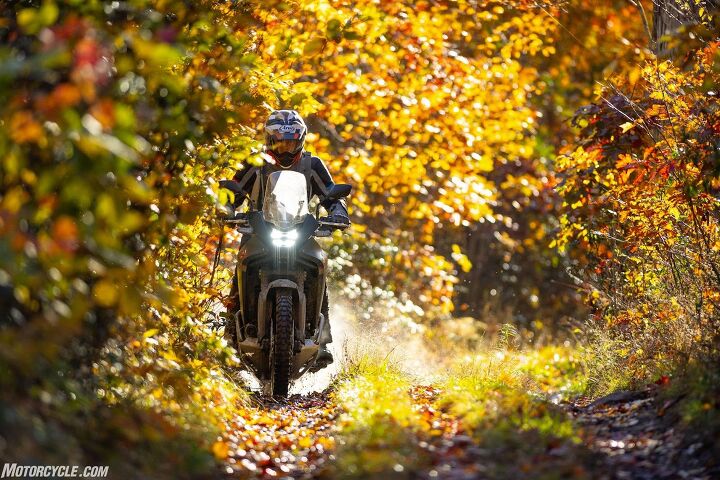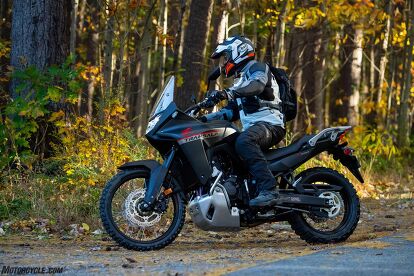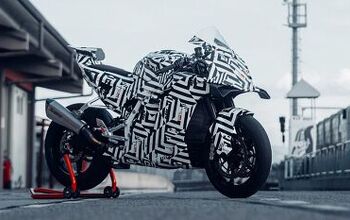2024 Honda Transalp Review – First Ride
A European staple comes to America
Adventure bikes weren’t really a thing in 1989, at least not in the United States. Even BMW’s venerable GS was nothing more than a misunderstood, oversized dual-purpose machine with ties to the Paris-Dakar rally, which itself was only a little more than a decade old at the time. At the back of the dealership where I worked in 1991, parked next to the tire rack, languished a 1989 Honda XL600V Transalp. Along with other two-year-only (’89 and ’90) model offerings from Honda, including the GB500 and CB-1, the Transalp was nothing more than a curiosity.
2024 Honda Transalp
Debuting stateside in the late ’80s, the Transalp is Honda’s OG adventure bike. For 2024 the Transalp returns as a more dirt-worthy stablemate to the NC750X.
Editor's score: 82.25%
Engine | 16.5/20 | Suspension | 11.5/15 | Transmission | 8.5/10 |
Brakes | 8.25/10 | Instruments | 4.25/5 | Ergonomics | 8.5/10 |
Appearance | 8.5/10 | Desirability | 7.75/10 | Value | 8.5/10 |
Highs
- Sub-$10k price tag
- Bi-directional quick-shifter
- Adjustable engine braking
Sighs
- Basic suspension
- Top-end-weighted engine performance
- Hope you like black
Flash forward thirty-five years and Honda is reintroducing the Transalp to American motorcyclists during a period when adventure bikes are as common as Taylor Swift songs. It should be understood that the Transalp only ceased to exist in our home market. During the interim, the Transalp was occasionally upgraded and offered abroad alongside other Euro-only models. Apparently, European motorcyclists understood the multi-discipline benefits of adventure bikes a generation before us.
With the reintroduction of the Transalp to US shores for the 2024 model year, Honda is casting a wider adventure bike net that will now include five models: Africa Twin, Africa Twin Adventure Sport ES, NC750X, and CB500X. As both the Transalp and NC750X are powered by 750-ish cc Parallel-Twins, think of the Transalp as the off-road option to the more streetable NC750X. In a nutshell, where the NC750X, with less than five inches of front and rear wheel travel, 5.6 inches of ground clearance, and 17-inch alloy wheels, prefers paved roadways, the Transalp, with 7.9 inches of front travel and 7.5 inches of rear travel, 8.3 inches of ground clearance, and rolling on 18-inch rear and 21-inch front spoked wheels is definitely the more dirtable model.
To prove the new Transalp’s off-road abilities Honda invited us to college football country to circumnavigate a portion of the PA Wilds BDR-X route. Embarking from our glamping experience at Godspeed Lodging it was a short distance to where the pavement turned to dirt. For more than 100 miles from this point we rode on a patchwork of gravel roads through leaf-strewn state parks to more technical two-track sections of granite, and, of course, some mud and water crossings. The Transalp, outfitted with more aggressive Bridgestone Trail AX41 tires compared to its stock Metzeler Karoo tires, took it all in stride.
No longer a MO staffer, I admittedly do not ride adventure bikes as often as I used to, making the sub-500 pounds of the Transalp (459-pound claimed curb weight) a welcome advantage to a diminished skillset. Those with the off-road chops easily rode the Transalp faster and more aggressively than I, proving that in the right hands, the Transalp is a capable performer. From my perspective, the Transalp, with its $9,999 MSRP, is an affordable ADV option for street bike riders who are adventure-curious.
The Transalp’s seating position/rider triangle was comfortable for my 5’ 11” frame, and while I had no problem with seat height for those who find its 33.7 inches from terra firma challenging, there exists a 32.6-inch seat in Honda’s accessory catalog. Wind protection seemed adequate for this kind of motorcycle, and while the windscreen is non-adjustable, it is designed to pop off rather than break in a minor crash. Our test bikes were outfitted with accessory heated grips that provided extra comfort during the brisk October mornings when our ride took place.
The new 755cc liquid-cooled parallel-twin four-stroke powering the Transalp is somewhat of a head scratcher. While the engine is outfitted with commonplace 270-degree crank rotation for that torquey mid-range punch, it is also of the very oversquare variety with a bore and stroke of 87.0mm x 63.5mm. This engine likes to spin, and on the street didn’t truly come alive until 2,000 rpm away from redline. At freeway speeds in sixth gear, there isn’t anywhere close to enough passing power. I found myself downshifting to fourth gear to bring revs up in order to efficiently get around slower-moving traffic.
I kept comparing the Transalp’s engine performance to the Suzuki V-Strom 800DE and its 270-degree firing order Parallel-Twin. I remember enjoying the torquey mid-range of the Suzuki’s engine, wanting to short-shift the motor in order to stay in the thick of its powerband compared to me constantly discovering the rev limiter of the Honda. Riding in the dirt the Transalp engine provided more than enough performance, but there was always a feeling of the engine reacting more as if it were in a drag race rather than being in a tractor pull.
Managing engine power, along with engine braking, ABS, and TC are Honda’s five rider modes consisting of Standard, Sport, Rain, Gravel, and User. Of the five modes, only User is editable for selecting your personal preference for engine power, engine braking, ABS, and TC, and for turning ABS and/or TC off. For the most part, the Transalp’s rider modes functioned similarly to other makes and models with similar technologies, but what I found I didn’t like was this. If the rider turns TC off in User mode it will turn back on when switching to another ride mode in accordance with that mode’s factory preset, but when returning to User mode not only does TC remain on, but it defaults to the most intrusive level of TC and not the TC setting of your preference.
What I did like about Honda’s system is that engine braking is included in the factory rides modes and adjustable to personal preference in User mode. In Gravel mode ABS stays on at the front wheel and gets reduced at the rear wheel, however, traction control is at level four, which is way too intrusive when riding in the dirt. It seems Honda wants the public to know this is a serious off-road adventure bike, but dumbs down the Gravel mode to a beginner setting. What would really be nice is if the factory mode settings were as adjustable as the User mode.
With only preload adjustability available on both the fork and shock, the Transalp’s suspension is where Honda sacrificed to help make its price point. Up front, the inverted, 43mm, separate function Showa fork has fifteen settings of preload adjustability. In the rear, there’s a Showa remote reservoir shock with seven settings of preload adjustability. During my two days aboard the Transalp I couldn’t find much to complain about regarding the Transalp’s suspension, but I reserve the right to change my opinion if ever given the chance to ride the Transalps in an environment of my choosing. So, kudos to the Honda engineers who found suspension settings that’ll keep most motorcyclists happy as long as they ride within the suspension’s limitations.
It needs to be said here that for its sub-$10,000 price tag, the Transalp does come equipped with a bi-directional quick-shifter. As with most quick-shifters, Honda’s works best on the street when the throttle’s at its stop with the engine spinning close to redline. Anything less than that and the quick-shifter’s operation is somewhat stiff. It’s in the dirt where I don’t mind a little clunkiness when using the quick-shifter. I just love the ease of selecting gears without clutch intervention while wearing off-road riding boots.
Braking performance from the Transalp’s dual, two-piston front Nissin calipers and 310mm discs, combined with its single-piston rear Nissin caliper and 256mm disc seemed up to the task of slowing the Transalp at the speeds it’ll be traveling. The motorcycle’s sub-500-pound weight helps with this task, while the adjustable front brake lever is an added benefit.
For anyone who, like me, has grown tired of man-handling an adventure bike with more than 1,000cc, and weighing in excess of 500 pounds, this new Honda may be your salvation. Or, as I mentioned earlier, for the newbie adventurist who doesn’t want to commit to the size and expense of an Africa Twin or similar model, the Transalp is worth checking out.
Now that I’ve ridden this new Transalp I wish I would have given more consideration to that neglected Transalp by the rear door of the dealership back in 1991. Maybe it would have changed the course of my motorcycling career. Ha! Who am I kidding? I was riding a CBR600F2, arguably the best sportbike of its era. And, besides, I wasn’t their target audience then or now. According to Honda, the most likely Transalp customer is a price/value-conscious motorcyclist 40 to 50 years of age who enjoys an outdoor lifestyle and traveling to new places. Is that you?
In Gear

- Helmet: Arai XD-4
- Jacket: Alpinestars Boulder Goretex
- Gloves: Alpinestars Corozal V2 Drystar
- Pants: Alpinestars Monteira Drystar XF
- Boots: Alpinestars Corozal
2024 Honda XL750 Transalp Specifications | |
|---|---|
Engine Type | 755cc liquid-cooled 24.5° inline-two-cylinder four-stroke w/ 270° crank |
Valve Train | OHC Unicam; 4 valves per cylinder; 35.5mm inlet valves, 29mm exhaust valves |
Bore x Stroke | 87.0mm x 63.5mm |
Compression Ratio | 11.0:1 |
Induction | PGM-FI; 46mm throttle bodies |
Ignition | Full transistorized |
Starter | Electric |
Transmission | Manual 6 speed |
Clutch | Multiplate wet |
Final Drive | 16T/45T; chain |
Front Suspension | 43mm Showa SFF-CATM telescopic inverted fork w/ spring-preload adjustment; 7.9 in. travel |
Rear Suspension | Pro-Link system w/ single Showa remote-reservoir shock; 7.5 in. travel |
Front Brake | Dual 310mm "wave" discs w/ hydraulic two-piston calipers; ABS |
Rear Brake | Single 256mm "wave" disc w/ hydraulic single-piston caliper; ABS |
Front Tire | 90/90-21 |
Rear Tire | 150/70R-18 |
Rake (Caster Angle) | 27° |
Trail | 4.4 inches |
Length | 91.2 inches |
Width | 33.1 inches |
Height | 57.2 inches |
Seat Height | 33.7 inches |
Ground Clearance | 8.3 inches |
Wheelbase | 61.5 inches |
Fuel Capacity | 4.5 gallons |
Curb Weight | 459 pounds (claimed) |
Color | Matte Black Metallic |
We are committed to finding, researching, and recommending the best products. We earn commissions from purchases you make using the retail links in our product reviews. Learn more about how this works.
Become a Motorcycle.com insider. Get the latest motorcycle news first by subscribing to our newsletter here.
A former Motorcycle.com staffer who has gone on to greener pastures, Tom Roderick still can't get the motorcycle bug out of his system. And honestly, we still miss having him around. Tom is now a regular freelance writer and tester for Motorcycle.com when his schedule allows, and his experience, riding ability, writing talent, and quick wit are still a joy to have – even if we don't get to experience it as much as we used to.
More by Tom Roderick






























































Comments
Join the conversation
@Stoddard Hodgson I think competition from Yamaha et al also caught up with the Transalp. BTW, you can still buy a carb ADV bike from Suzuki. The DR-650S can still be had brand new hardly change from back in the day.
Insert This is Spinal Tap scene......"Could it get any blacker?"